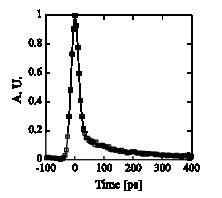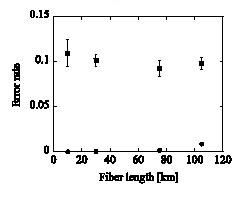Hiroki
Takesue1, Eleni Diamanti2, Carsten Langrock2, Martin M. Fejer2, and Yoshihisa Yamamoto2
1Optical Science
Laboratory, 2Stanford University
We employed differential phase shift quantum key distribution protocol [3]. An actively mode-locked laser output a 10-GHz clock pulse train whose wavelength and pulse width were 1551 nm and 10 ps, respectively. The phase of each pulse was randomly modulated by 0 or π. Then, the pulse train was attenuated so that the average photon number per pulse becomes 0.2, and transmitted over optical fiber. The output pulses from the fiber were launched into a 1-bit delayed interferometer, which was followed by two UCDs. In an UCD, a signal photon was combined with a 1319-nm pump light and injected into a PPLN waveguide, in which the signal photon was up-converted to a 700-nm photon. After suppressing noise photons with optical filters, the up-converted photon was detected by a low-jitter Si APD. With those detectors, we were able to receive high-speed photon trains with a high timing resolution.
Figure. 1 shows the histogram of detected signal when 3-ps pulses were input into an UCD. Although the full width at half maximum of the timing jitter was as small as 30 ps, a large tail was observed. We then adjusted the quantum efficiency, combined dark count rate, and time window width at 0.3%. 750 cps, and 10 ps, and undertook quantum key distribution. The sifted key rate at 100 km was 3.7 kbit/s. The obtained error rate as a function of fiber length is shown with squares in Fig. 2. The error rate was around 10%, which was due to the tailing characteristics of jitter. Interestingly, we did not observe significant variation in the error rate when we used fibers with different lengths. This indicates that the use of short pulses and narrow time window improved the ratio between signal and dark counts per time slot. Circles in Fig. 2 show estimated error rate due to dark counts. A dark count-induced error rate was suppressed to less then 1% even after 100 km transmission. Therefore, we can expect significant improvement in the error rate by improving the UCD timing jitter characteristics.
[1] H. Takesue, et al., Opt. Express 14 (2006) 9522.
[2] C. Langrock, et al., Opt. Lett. 30 (2005) 1725.
[3] K. Inoue, E. Waks, and Y. Yamamoto, Phys. Rev. Lett. 89 (2002) 037902.
 |
 |
|||||
|
|